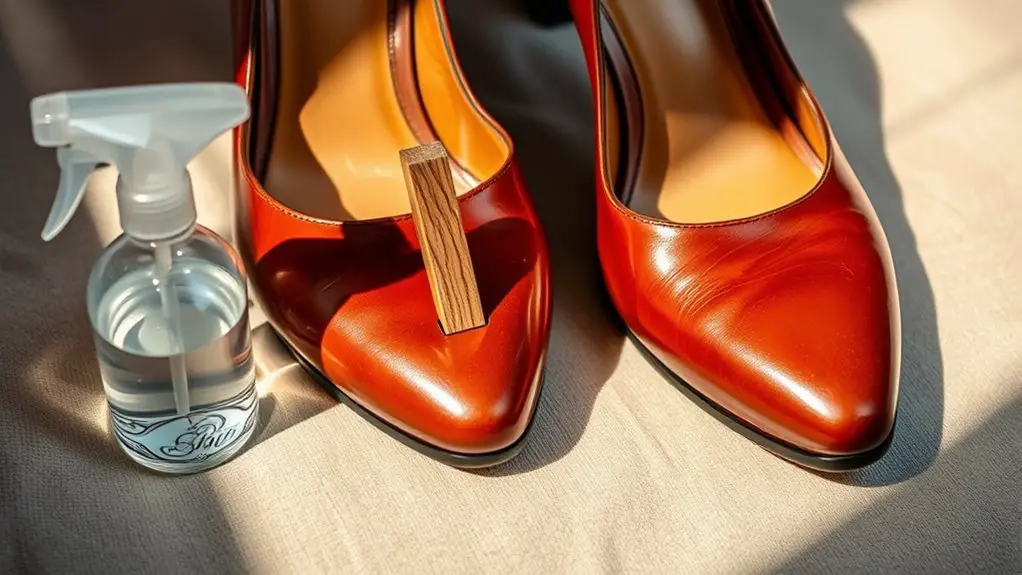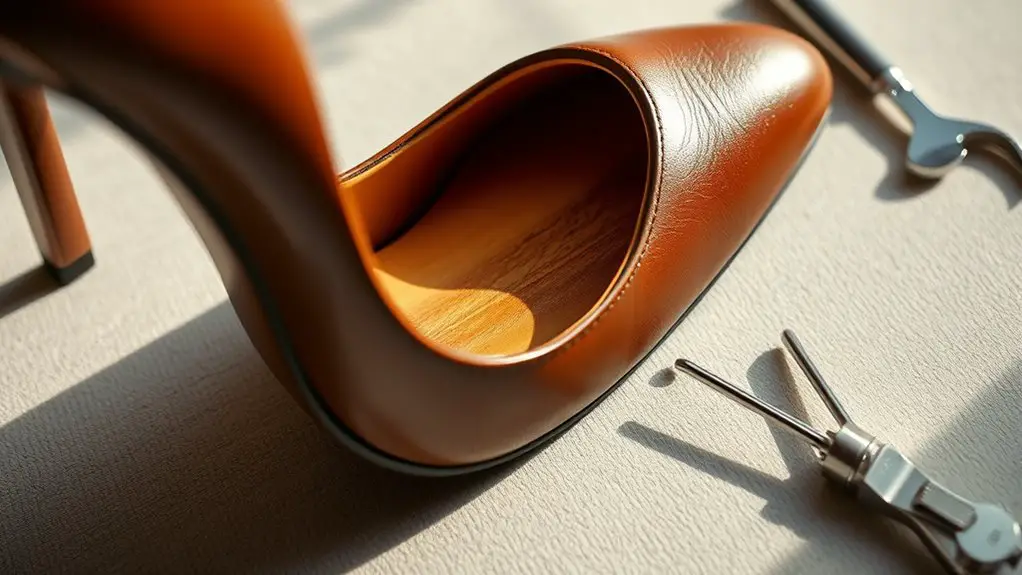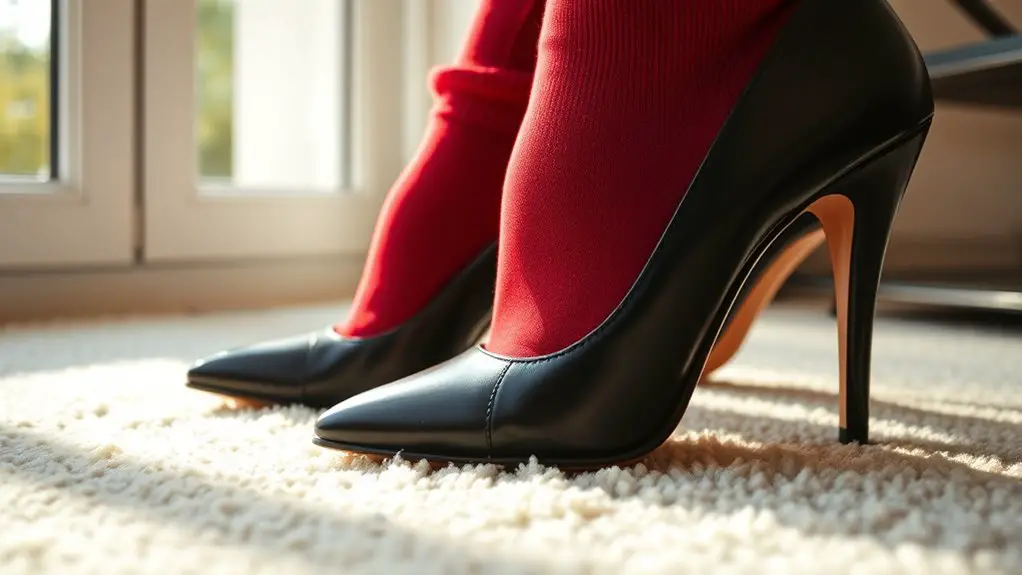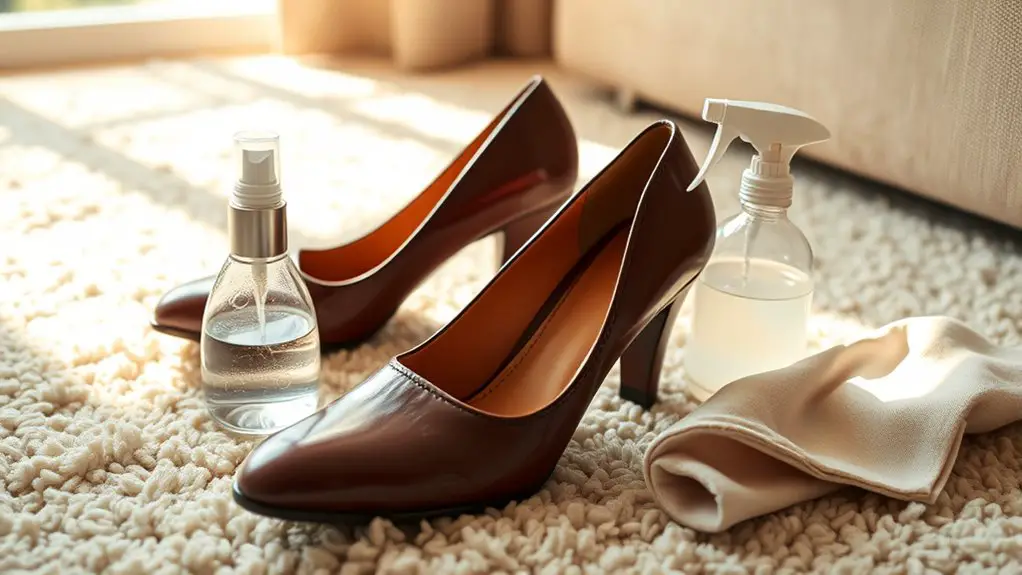To stretch tight heels for a more comfortable fit, consider using a shoe stretcher or the freezing method: place a sealed bag of water in the shoe and freeze it. You can also wear thick socks to help stretch the material. Applying heat for a brief period can mold the shoes to your feet, enhancing comfort. For persistent issues, consulting a professional cobbler may provide tailored solutions. Learn additional strategies to guarantee lasting comfort ahead.
Understanding the Causes of Tight Heels

Understanding the causes of tight heels is essential for effectively addressing discomfort and enhancing mobility. Various factors contribute to this condition, including the heel structure and surrounding soft tissues. Tightness often arises from muscular imbalances, where certain muscle groups become overactive while others weaken, leading to restricted movement. Additionally, cumulative stress from repetitive activities or improper footwear can exacerbate the discomfort.
Inflammation of the plantar fascia may also play a role, causing pain and tightness. Changes in gait mechanics, whether due to injury or habitual movement patterns, can further contribute to heel tightness. When you understand these underlying causes, you can better identify the specific factors affecting your comfort. Recognizing the interplay between heel structure and surrounding muscles is vital for developing effective strategies to alleviate discomfort and improve overall mobility. Taking proactive steps based on this understanding can lead to significant improvements in your foot health.
Choosing the Right Shoe Size
Choosing the right shoe size is essential for preventing and alleviating tight heels. You should start by measuring your foot size accurately to guarantee a proper fit. Additionally, considering width options can further enhance comfort and reduce pressure on your heels.
Measure Your Foot Size
Finding the right shoe size is essential for comfort and preventing issues like tight heels. Accurate foot measurement techniques play a vital role in determining shoe sizes. Here’s how to measure your foot effectively:
- Gather materials: You’ll need a ruler or measuring tape, a piece of paper, and a pen.
- Trace your foot: Stand on the paper and trace the outline of your foot, keeping the pen vertical.
- Measure length: Measure the longest distance from heel to toe in inches or centimeters.
- Determine size: Use a shoe size chart to find your corresponding shoe size based on the length measurement.
Consider Width Options
While it’s common to focus solely on length when selecting shoes, considering width options is equally important for overall comfort and fit. Shoes come in various widths, and choosing the right one can prevent discomfort, especially for tight heels. Different shoe materials also play a role; for example, leather may stretch more than synthetic materials, impacting how the shoe conforms to your foot. Additionally, heel shape variations can affect your foot’s positioning within the shoe, further influencing fit. When shopping, always try on different widths and pay attention to how the shoe feels around your arch and heel. A proper fit will enhance comfort and reduce the risk of blisters or other foot issues.
Using a Shoe Stretcher

Using a shoe stretcher can effectively alleviate tightness in your heels. It’s crucial to choose the right stretcher and apply proper stretching techniques to guarantee the best results. This discussion will guide you through selecting the appropriate stretcher and the best practices for stretching your shoes.
Choosing the Right Stretcher
When it comes to alleviating tightness in your heels, selecting the right shoe stretcher is crucial for effective results. You’ll want to take into account the following factors to guarantee ideal comfort:
- Shoe Stretcher Types: Choose between wooden stretchers for durability or plastic ones for lightweight use.
- Effective Materials: Look for stretchers made from quality materials that can withstand pressure without breaking.
- Adjustability: Opt for a stretcher that allows for precise adjustments to target specific tight areas.
- Size Compatibility: Confirm the stretcher fits the size and shape of your shoes, particularly if you have different styles.
Proper Stretching Techniques
To effectively stretch tight heels, it is essential to employ the correct techniques with your shoe stretcher. Start by using dynamic stretches, which involve moving your foot in a controlled manner while the stretcher is in place. This helps warm up the materials of the shoe, allowing for better flexibility. Next, incorporate static stretches by leaving the stretcher in your shoe for an extended period, ideally overnight. This method gradually expands the shoe’s heel area without causing damage. Be sure to monitor the stretching process closely; over-stretching can lead to irreversible alterations. Finally, always test the fit after stretching to guarantee comfort and avoid discomfort during wear. Properly utilizing these techniques can greatly improve your shoe’s fit.
The Freezing Method
Although many methods exist for alleviating tight heels, the freezing method stands out for its simplicity and effectiveness. This technique utilizes the properties of ice to help stretch your shoes, providing a more comfortable fit.
To implement the freezing method, follow these steps:
- Get an ice pack: Fill a resealable plastic bag with water and seal it tightly.
- Position the bag: Place the bag inside your shoe, focusing on the heel area.
- Freeze: Put the shoe in the freezer for several hours, allowing the water to turn into ice.
- Remove and wear: After freezing, take the shoe out, let it thaw slightly, then wear it to help mold to your foot shape.
This method not only stretches the material but also allows for a gradual fitting process, making your heels notably more comfortable over time.
Wearing Thick Socks

Wearing thick socks can considerably enhance comfort when dealing with tight heels, as they provide additional cushioning and can help stretch the shoe material. The right sock thickness and fabric types play an essential role in this process. Here’s a quick guide to help you choose the best options.
| Sock Thickness | Fabric Types |
|---|---|
| Light (1-2 mm) | Cotton |
| Medium (3-4 mm) | Wool |
| Thick (5-6 mm) | Fleece |
| Extra Thick (7+ mm) | Merino Wool |
| Compression | Spandex Blend |
When selecting socks, consider how the thickness interacts with your shoes. Thicker socks can create a snugger fit while promoting gradual stretching of the shoe material. Opt for breathable fabrics to maintain comfort, especially during extended wear. This method provides an effective, non-invasive way to alleviate tightness in your heels.
Applying Leather Conditioner
When you notice your leather shoes feeling tight, applying leather conditioner can be an effective solution to soften the material and promote a better fit. Proper leather care is essential for maintaining the longevity of your shoes. Here are some conditioning tips to follow:
- Choose the Right Conditioner: Opt for a high-quality leather conditioner that suits your shoe type.
- Clean the Shoes: Use a damp cloth to remove dirt and debris before applying the conditioner.
- Apply Evenly: Use a soft cloth or sponge to apply the conditioner evenly, focusing on tight areas.
- Allow to Absorb: Let the conditioner sit for the recommended time to fully penetrate the leather, usually 15-30 minutes.
Utilizing Heat for Stretching
If you’ve tried conditioning your leather shoes and they’re still tight, utilizing heat can be an effective method for stretching them. Start by ensuring proper temperature control; excessive heat can damage the leather. Use a hairdryer on a low setting and focus on the tight areas, keeping the nozzle about six inches away. Move the dryer in circular motions to evenly distribute heat.
Alternatively, you can wear thick socks and then put on your shoes. Apply heat using the hairdryer while wearing them, allowing the leather to stretch around your feet.
After the heat application, walk around in your shoes for about 10-15 minutes, which aids in molding them to your feet. Allow the shoes to cool down while still on your feet to maintain the new shape. This method can greatly enhance comfort without compromising the integrity of your leather footwear.
Visiting a Professional Cobbler
After attempting heat methods to stretch your shoes, consulting a professional cobbler might be the next best step. Cobbler services specialize in proper shoe repairs, ensuring your footwear fits comfortably without compromising structural integrity. Here are four reasons to ponder visiting a cobbler:
- Expert Assessment: A cobbler can evaluate your shoes and determine the most effective stretching method based on the material and construction.
- Custom Stretching: Professionals use specialized tools to stretch tight areas precisely, addressing discomfort without damaging your shoes.
- Quality Repairs: If your shoes have additional issues, cobblers can perform necessary repairs, prolonging the lifespan of your favorite pairs.
- Advice on Fit: Cobblers can provide recommendations on future shoe purchases, helping you avoid similar fit issues.
Investing in professional cobbler services can lead to a more comfortable and enjoyable wearing experience for your shoes.
Preventative Measures for Future Comfort
To guarantee your heels remain comfortable in the future, it’s essential to take proactive steps in selecting and caring for your footwear. Start by investing in well-fitted shoes that accommodate your foot shape and size. Avoid overly tight styles, as they can lead to discomfort and long-term issues. Regular foot care is important; consider using moisturizing creams to keep skin supple and prevent cracking.
Additionally, shoe maintenance plays a significant role in comfort. Clean your shoes regularly to remove dirt and grime, which can affect material flexibility. Store your footwear properly, using shoe trees to maintain shape and prevent creasing. Rotate your shoes to avoid excessive wear and allow them to breathe. Finally, consider insoles for added cushioning and support. By following these measures, you’ll reduce the risk of discomfort and make sure your heels remain a reliable choice for everyday wear.
Frequently Asked Questions
Can I Stretch Synthetic Shoes Like I Can With Leather?
You can’t stretch synthetic materials as effectively as leather. While some stretching methods, like heat or using shoe stretchers, may work, results often vary, and excessive force might damage the shoes. Proceed with caution.
How Long Does It Take to Stretch Tight Heels?
When it comes to stretching tight heels, you’ll need patience. Depending on the stretching techniques used, it can take a few days to a couple of weeks to alleviate heel pain considerably.
Will Stretching Shoes Affect Their Appearance?
Stretching shoes might slightly alter their appearance, but with proper shoe maintenance and careful stretching techniques, you can minimize any negative effects. Regular checks can help guarantee your shoes remain visually appealing post-stretching.
Are There Specific Brands Known for Tighter Heel Fits?
You might find that brands like Nike often have tighter heel fits compared to others. When making brand comparisons, consider heel measurements carefully, as this can greatly impact comfort and fit for your specific foot shape.
Can High Heels Be Stretched Effectively?
Yes, high heels can be stretched effectively, especially if made from certain shoe materials like leather. To enhance comfort, consider using professional stretching services or applying specific comfort tips at home for ideal results.



